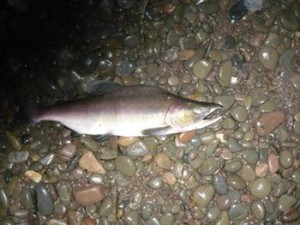By Kirsty Topping

A NATIONWIDE “kill on sight” alert has been issued after a foreign species of salmon was pulled from a Scottish river.
A humpback salmon was found in the River Tweed in a discovery that could spell disaster for the native King of Fish.
If humpbacks breed and wipe out Scottish salmon that would also threaten thousands of jobs and around £1bn earned each year from the fish.
Experts have issued a Scotland-wide warning to fishermen, telling them to kill any humpbacks they catch and report the find to the government.
The humpback – or pink salmon – is native to the Pacific Ocean but has already invaded river systems in Norway and appears to have made its way across the North Sea.
The confirmed Scottish discovery of a humpback was made on August 2 when one of the fish was caught in nets at Paxton, in the Scottish Borders.
The fish was ready to breed and officials fear it is only a matter of time before the species starts producing young in Scottish rivers.
There have been at least two other unconfirmed sightings of humpbacks in the area. It has also emerged that a humpback was recently found at a fishmongers in Kelso, having been caught in Amble, Northumberland.
Alan Wells, policy director of the Association of Salmon Fishery Boards (ASFB), revealed he had issued a Scotland-wide alert to be on the look-out for the fish.
“I’ve asked for the boards to keep ASFB and the Scottish Government updated of any fish they catch and to remove them from the river.”
Nick Yonge, clerk to the River Tweed Commission, said: “It looks like there are quite a few knocking around. Their natural distribution is in the north Pacific. But they were brought into Russia and there is now an established population in Norway.”
Explaining the order to kill any fish found, he added: “We don’t want anglers to land one and think that it’s some specialty that has to be preserved.
“They are not native to this part of the world. They are an invasive species so we don’t want them to establish themselves.”
Mark Bilsby, director of the Dee district salmon fisheries board, echoed the warning.
“The introduction of non-native species can be damaging – just look at what happened to red squirrels when greys were introduced.
“It’s much harder to get rid of them when they are here than it is to prevent them coming in the first place.
“They are not good for the Scottish salmon as it means competition for resources in the river.
“There is only so much space in the river and if you have foreign species in there taking up resources then it’s not good for the native fish.”
At risk if humpback salmon colonise Scotland’s rivers are at least 6,000 jobs that depend on the industry. Exports alone are worth £300m.
The humpback is smaller than the Scottish – or Atlantic salmon – but has proved spectacularly successful at spreading around the globe, also colonising rivers in Canada.
The male fish have a distinctive hump near their dorsal fin when they are sexually mature, as well as a pronounced curve of their jaw.
The fish, which grow up to 2ft in length, have distinctive pink flesh – as opposed to the orange hue of Atlantic salmon – and are most likely to be used in the canned product.
The Scottish Government backed the moves to protect the country’s great salmon rivers.
A spokeswoman said: “Freshwater fisheries to be vigilant in identifying non-native species, and raising awareness of the importance of protecting Scotland’s natural biodiversity.”